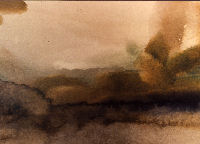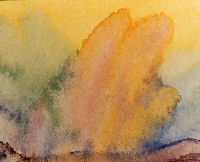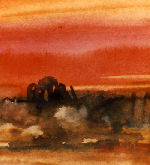|
|
|
Purcell and Elmslie, Architects Firm active :: 1907-1921
Minneapolis, Minnesota :: Chicago,
Illinois |
Ye Older Grindstones
10/22/2005
We're B-A-C-K. Okay, okay. I'll do one a week. Thanks for the appreciation. These postings have taken on a life of their own, or at least a readership. Even with these month or two long interregnums, the pokes, prods, and nudges come: "Where's my Grindstone?!" Purcell would be gratified people are so interested in his work. Certainly I am merely a conduit, perhaps only a leaky vessel. However, with the virtue of transferring much of the historical content from the Grinds to the Musings and other place, I can be more personal here, something that I think was my original intention anyway.
In the "Yes, It's Spooky" Department: It's been a while since anything truly non-local happened to me with P&E. The last event was that copy of Tertium Organum that came to hand. When I was handling the Purcell Papers on a daily basis, particularly in the very early 1980s before I knew enough to have an inner matrix (read: filter) that could connect the dots of familiar documentation, I used to experience ver-r-r-r-r-y strange psychic occurrences whose product was often information that only much later came to have some evidentiary basis. In a way I kind of miss that sense of connection, of having the pure and original vibration within the crystal of the document or artifact transfer from my hands to my mind. So whether it was psycho-kinesis, dipping into the Zero Point Energy field for pre-existing knowledge patterns, hearing the ghosts of Purcell and, yes, Elmslie, or whatever description zoots the suit, such high strangeness has always been part and parcel of my journey with P&E.
Of course, only those who have awareness of the validity of such perceptions can credit their existence. The light bulb is either on, or it is not. However, if P&E is more than horizontal lines and loquacious enrichments to the fair reader, then it is necessary to wrap yourself around the psychic. A friend recently submitted a proposal to a meeting of the (presumably) organically minded to present his perspective on the fundamental presence of spirituality in the P&E. His paper was rejected, as I told him it would be. A century after it all started, people don't want to hear this stuff. They want nice comfortable inventories of Roman bricks and strips of interior trim systems. They want to know how many square feet and who did the drawings. Anything tangible, material, quantifiable is welcome at the table of reductionism. Raise the intangible of spirituality, the intentional psyche of inner creative states, and the authoritarian reaction is like someone farted.
Yet, even the slightest dip beneath the surface of flat files and shelf boxes leads inevitably to Atlantis, so to speak, whose cyclopean blocks litter both the seafloor and the continents with the white elephant of denied presence. Coffee table books don't satisfy that understanding, and mindfulness is the entire raison d'etrere of P&E. They declaimed this in The Statics and Dynamics of Architecture, but as with Sullivan's genitive efforts Purcell and Elmslie stumbled into the roadblock of difficult elocutions that meant, in the end, they were only preaching to the choir. Arguments against historical revivalism are merely the outermost cloak of Purcell and Elmslie's purpose, not their inner meaning.
The world, however, was already headed inexorably into the hellish realm of "scientism," which houses an academic establishment whose great distinction is a round robin of back-scratching credentials, degrees, and awards to perpetuate a medieval model of "authority." Frank Lloyd Wright established the Taliesin Fellowship to counter this baleful influence in architecture, and Purcell spent a lifetime of writing toward that same end. He offered $10,000 to his alma mater Cornell if architecture students would touch the crafts of building and put up a house. Naturally, the idea pf practicum was rejected, though the coy hope of getting the money anyway accompanied the reply.
8/20/2005
Revisions to the Home Page reflect forthcoming changes to the site (see P&E News) and diminution for the continuum known as The Grindstone. "It's all good."
7/31/2005 : : A Grindstone Risen
Chromograph
William Gray Purcell
Circa 1960
Chromograph
William Gray Purcell
Circa 1960
Chromograph
William Gray Purcell
Circa 1960Chromographs. In the last Grind I looked at Purcell's lifelong interest in photography in every form he could find. In the end, he even developed (pun intended) one of his own whose prints were called chromographs. Since his physical activity became more limited after a resurgence of tuberculosis in 1954--which forced him to give up his hobbyhorse of writing for Northwest Architect--he turned with interest to micrography, a technique brought to him by a visiting friend. Purcell immediately became entranced. After discovering that by using microscopic lenses he could capture compelling images from even the most mundane surfaces (the discolored edge of a piece of art board, for example), the thought occurred to him that a deeper lyricism might be obtained by manipulating the process of development. Although his weakened condition did not allow him to keep a darkroom at home, Purcell started sending out detailed instructions to the photo lab on the adjustment of color hue and saturation. The results made his last fling with photography a unique and creative expression.
Chromographs were quite successful for their time. A selection of the images, each with a poetic name that sometimes had more to do with Purcell's obscure reminiscences that something Joe Average might get out of the title, were exhibited in Sweden and at schools of architecture in the United States. A large number were signed, mounted on matte boards, and became gifts for a variety of longtime correspondents and friends. A large but incomplete collection survives with his papers at the Northwest Architectural Archives. In a way, the chromographs were the final outreach by Purcell to a larger world. The reprographic techniques of the day limited their public exposure. Even if the images had not been defined by their specific color values, something that even secondary photography fails to capture, the expense of publication would have been too great. Lucky were those there at the time.
Just for fun, I thought I would try my own hand at graphical whimsy. I took various photographs of P&E details, and sent them through an equivalent kind of treatment in a graphics software program. Each of them contains a pun in the title that references the history of the original image. I call the results A Gallery of Shadow and Light [opens a new browser window]. Turns out the experiment was useful in understanding that beyond creating an art form, Purcell was also having fun.



